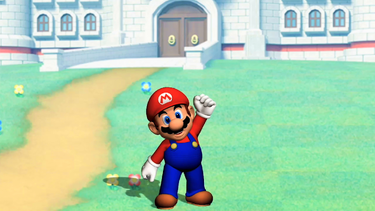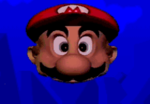Mario in Real Time
Mario in Real Time (more commonly known as MIRT) is an interactive system developed by SimGraphics and introduced in 1991,[1][2] and has since been used by Nintendo across various promotional events. Thought up by SimGraphics CTO Mike Fusco,[3][4] MIRT is notable for being Charles Martinet's first role as Mario (prior to his video game debut in Mario Teaches Typing).
The system, based on Fusco's VActor and AI-VActor technology, allows an actor (almost always Martinet), as well as artificial intelligence,[5] to communicate with passersby as Mario, alongside other characters, such as Luigi and formerly Wario and Donkey Kong.
MIRT has been repeatedly used by Nintendo throughout the years for promotional events all the way up to present day, modern examples including San Diego Comic-Con 2012 and the Nintendo New York Luigi's Mansion: Dark Moon launch event in 2013 (the former having featured Martinet as Mario answering questions from fans,[6] while the latter involved Luigi welcoming fans to the Dark Moon launch event).[7]
History
Developed by Mike Fusco, SimGraphics' VActor technology was pitched to multiple companies as a form of promotion, including Nintendo, who quickly took interest and contracted them to create a system featuring Mario based on the technology.[3][4] Auditions were overseen by the producer who ran the events MIRT would appear in,[4] in tandem with Don James, executive vice president of operations for Nintendo of America.[8] As the audition was ending, it was crashed by Charles Martinet, who managed to convince the producer to let him try out. According to Martinet, the producer was seemingly annoyed by his performance by the time he left, but purportedly called James immediately to urge him that only Martinet's audition be sent to Japan.[8]
He was very quickly hired, and flown out to do shows through MIRT.[9] Due to the long shifts, by Martinet's suggestion, Stevie Coyle was hired as a voice match for several early shows.[2][10] At this time, the system had Mario, and later Wario and Donkey Kong, who were added after the release of Wario Land: Super Mario Land 3 and Donkey Kong Country, respectively.[11][12] Both were performed by Martinet solely as Coyle retired from acting not long after starting MIRT.
Around 2000, Donkey Kong was removed from the system, and Mario and Wario were updated to their current designs.[13][14][15] More notably, however, expressions and mouth movement became automatized, which meant face tracking equipment was no longer needed, allowing the characters' full bodies to be rendered, and Martinet to perform from anywhere in the world.[16] Mario and Wario remained as the sole characters until 2012, when Wario was removed but Luigi was added (first appearing at the aforementioned San Diego Comic-Con 2012), alongside another overhaul of the system.
In 2021, an updated version of MIRT was introduced utilizing AI-VActor technology, which allows for an AI duplicate of Martinet (or rather, Mario) to fill in when he is not available.[5] So far, no unique duplicate has been shown off or announced for Luigi.
As of present, MIRT has been retired from event appearances, and is used exclusively for promotion at Nintendo New York, originally most commonly during the holiday season,[17][18] however with AI-VActor technology, MIRT is now avaliable 6 days a week at Nintendo New York.[5]
Overview
MIRT is engaged through its display, which shows either Mario or Luigi in front of a background. People would interact with them through a hidden camera and microphone, though modern displays place the mic in clear view.[3][19]
Formerly, the system required a headset rig, which would transpose the actors' expressions using roller balls onto a model of the character. The system also formerly required everything to be connected together, likely caused by the limits of computing power at the time. With the first overhaul of the system around 2000, however, expressions and mouth movements became automatized, which allowed for Martinet to perform remotely.
Under most circumstances, both characters cannot be seen at the same time. Previously, this was a technical limitation, as each character would need their own display, with a computer and headset rig,[11][12] though today it is purely Martinet playing both characters. Despite this, however, certain transitions between the characters do show them both on screen, which Martinet uses as an opportunity to voice them both, going back and forth between them.[20]
The AI-VActor model is trained on data from Martinet's more recent MIRT performances[5] and can perform all the same actions he can, though no unique duplicate has been shown off or announced for Luigi.
Gallery
Shigeru Miyamoto and a Mario mascot, standing in front of a MIRT display
References
- ^ https://twitter.com/CharlesMartinet/status/1493266234644779012?s=09
- ^ a b Template:Media link
- ^ a b c SimGraphics homepage.
- ^ a b c Guinness World Records (December 13, 2018). Charles interviewed on GWR podcast. YouTube. Retrieved Febuary 7, 2023.
- ^ a b c d AI-VActor press release
- ^ Patrick Scott Patterson (July 16, 2012). Mario reveals his last name & other tales - San Diego Comic Con 2012. YouTube. Retrieved May 8, 2016.
- ^ CubedLink (March 27, 2013). Luigi's welcome at the 'Luigi's Mansion: Dark Moon' Nintendo World launch. YouTube. Retrieved May 8, 2016.)
- ^ a b Interview with Charles Martinet.
- ^ http://www.gooddealgames.com/interviews/int_Charles_Martinet.html
- ^ DigitalNeohuman (April 23, 2010). Real Time Mario at the 1992 SCES. YouTube. Retrieved April 19, 2013.
- ^ a b WIRT
- ^ a b DIRT
- ^ https://www.youtube.com/watch?v=9ihWsOcbS_E
- ^ https://www.youtube.com/watch?v=rA4u6BkHBgc
- ^ https://www.youtube.com/watch?v=iXzTFIL6tPU
- ^ https://www.youtube.com/watch?v=9ABOLF2htwE
- ^ https://twitter.com/NintendoNYC/status/935641539317063681
- ^ https://twitter.com/nintendonyc/status/1073952261833936896
- ^ Template:Media link
- ^ https://www.youtube.com/watch?v=slYuzfVucyE&t=395s






